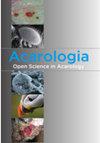New records of phytoseiid mites (Acari: Phytoseiidae) on solanaceous plants in the Syrian coastal region
IF 0.9
3区 农林科学
Q3 ENTOMOLOGY
引用次数: 0
Abstract
Phytoseiid mites have been considered the most promising predators for the control of pest mites and small insects. Their use in solanaceous crops for the biological control of major mite pests represents an important challenge and requires continued research. This study aimed at investigating the phytoseiid species and their associated phytophagous mites on eggplant (Solanum melongena), tomato (Solanum lycopersicum) and black nightshade (Solanum nigrum) in the Syrian coastal region between 2018 and 2020, at 40 sites. A total of 12 species of the three subfamilies (Amblyseiinae Muma, Phytoseiinae Berlese, and Typhlodrominae Scheuten) were collected, with Amblysiinae being the most represented. Among them, Amblyseius andersoni (Chant) is a new record for the Syrian fauna. Phytoseiulus persimilis Athias-Henriot was the most abundant (223 specimens; 47.3%) and frequent (found in 22 out of 40 sites) species collected on all plant species surveyed and the only common phytoseiid species in greenhouses. The second most abundant species was Neoseiulus californicus (McGregor) (83 specimens: 17.6%), while the second most frequent was Phytoseius finitimus Ribaga (8 sites). Species found in this study should be considered in future research on phytoseiid mites as biological control agents of pests of tomato and eggplant cultivated in greenhouses and open fields in this region.叙利亚沿海地区茄科植物上的植物寄生螨新记录(Acari:Phytoseidae)
植生螨被认为是控制害虫螨和小昆虫最有前途的捕食者。它们在茄科作物中用于主要螨类害虫的生物控制是一个重要的挑战,需要继续研究。本研究旨在调查2018年至2020年期间叙利亚沿海地区40个地点茄子(茄属)、番茄(茄属番茄)和黑茄属(茄属黑茄)上的植物寄生虫及其相关的植食性螨。共收集到三个亚科(Amblysiiinae Muma、Phytoseiinae Berlese和Typhlodrominae Scheuten)的12个物种,其中Amblysiinae最具代表性。其中安氏Amblysius andersoni(Chant)是叙利亚动物群的新记录。在所调查的所有植物物种中,persimilis Athias Henriot Phytoseiulus是最丰富的(223个标本;47.3%)和最频繁的(在40个地点中的22个地点发现)物种,也是温室中唯一常见的植物感染物种。数量第二丰富的物种是加利福尼亚新殖藻(McGregor)(83个标本:17.6%),而数量第二频繁的物种是有限殖藻(Phytoseius finitimus Ribaga)(8个地点)。本研究中发现的物种应在未来研究中作为该地区温室和开阔地栽培番茄和茄子害虫的生物防治剂。
本文章由计算机程序翻译,如有差异,请以英文原文为准。
求助全文
约1分钟内获得全文
求助全文
来源期刊

Acarologia
ENTOMOLOGY-
CiteScore
2.00
自引率
18.20%
发文量
81
期刊介绍:
Acarologia is a free open-access journal. Please help us by submitting manuscripts in accordance with following instructions.
All manuscripts which do not conform to the instructions will be returned to authors without the benefit of review.
Acarologia publishes the results of original research on all aspects of Acarology.
The journal policy is that taxonomic descriptions should include several species within a same genus/family, when possible.
The editors reserve the right to refuse manuscripts when authors intentionally divide individual species descriptions of the same genus/family into distinct publications.
Single species descriptions should be clearly justified based on their scientific interest.
 求助内容:
求助内容: 应助结果提醒方式:
应助结果提醒方式:


